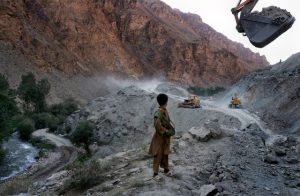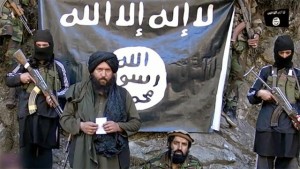Brian M Downing
The war in Afghanistan has dragged on for fifteen years now. The conflict has been complicated by the rise of ISIL in the region. Its Afghan franchise, ISIL-Khorasan Province, has established itself in eastern Afghanistan, where it has coalesced with and recruited from other jihadi groups, including al Qaeda and Lashkar-i-Taiba.
This has caused concern in Russia, China, and Pakistan who fear the spread of Islamist militancy into their countries and spheres of influence. Critically, the three powers consider the United States an obstacle to their national aspirations. They have gathered in Moscow to forge a plan. Neither the US nor Afghanistan has been invited. Russia, China, and Pakistan see an opportunity to defeat ISIL in Afghanistan and weaken the United States in one fell swoop.
Assets
 Over the years China has come to dominate Afghanistan’s natural resources – oil, iron, copper, and rare earths. Some mines and oilfields are operating and hauling commodities out of the country on railroads built by China. Other operations are on hold. Dominance came through deals with the Kabul government, usually occasioned by timely gifts of stuffed briefcases.
Over the years China has come to dominate Afghanistan’s natural resources – oil, iron, copper, and rare earths. Some mines and oilfields are operating and hauling commodities out of the country on railroads built by China. Other operations are on hold. Dominance came through deals with the Kabul government, usually occasioned by timely gifts of stuffed briefcases.
Pakistan has backed the Taliban since the early nineties when it recognized the movement’s usefulness. The Taliban could establish, however roughly, a measure of law and order in a country plagued by warlordism. This would allow Pakistan to become an export route for Central Asia’s commodities. The Taliban were also useful in the rivalry with India, providing training camps for Kashmiri guerrillas and strategic depth in the event Indian invasion.
 Though defeated in Afghanistan, Russia retains ties with the old warlords of northern Afghanistan. Uzbek chief Mohammed Dostum, for example, has met with Vladimir Putin twice in the last year. Dostum is an alumnus of the Soviet Military Academy and once led an Afghan airborne division alongside Russian troops until opportunistically going over to the mujahideen.
Though defeated in Afghanistan, Russia retains ties with the old warlords of northern Afghanistan. Uzbek chief Mohammed Dostum, for example, has met with Vladimir Putin twice in the last year. Dostum is an alumnus of the Soviet Military Academy and once led an Afghan airborne division alongside Russian troops until opportunistically going over to the mujahideen.
Russia controls the northern supply route upon which US efforts in Afghanistan depend. Pakistan controls the southern route. No supply routes, no American influence.
Goals
Russia, China, and Pakistan want the Taliban to control several provinces, mostly in the south and east, and to eliminate ISIL. Russia fears ISIL expansion into its Near Abroad in Tajikistan and other former Soviet Republics. China worries that Uighurs now serving with ISIL will return to western China and greatly bolster discontent there. Parts of the Pakistani Taliban have already sworn allegiance to ISIL and strike in the Pashtun areas, Balochistan, and even the Punjab.
 The Taliban have had an internationalist wing since the days of Mullah Omar’s government in the late nineties. The three powers will solidify the Taliban’s less ambitious wing and focus attention on eliminating their ISIL rivals. Sharing the country’s export revenue with an autonomous Taliban region will be an inducement.
The Taliban have had an internationalist wing since the days of Mullah Omar’s government in the late nineties. The three powers will solidify the Taliban’s less ambitious wing and focus attention on eliminating their ISIL rivals. Sharing the country’s export revenue with an autonomous Taliban region will be an inducement.
This will come at the expense of unifying Afghanistan. A Taliban region in the south and east, or at least parts thereof, will be abhorrent in both Kabul and Washington. Though perhaps attractive to Islamabad at present, the region could one day align with Pakistan’s Taliban and become a source of further fragmentation of the already failing state.
The north
The American position will be tenuous. Pakistan and Russia, by closing down the supply routes, could force the US out of Afghanistan. Alternately, they could control the scope of American efforts there, limiting them to development programs.
Northern Afghans – Tajiks, Uzbeks, Hazaras, and Turkmen – will not be pleased to see former oppressors supported by foreign powers and given parts of the country. Their mistrust of Pakistan and the Pashtuns is strong. Iran, another state conspicuously absent from negotiations, though likely to be in cahoots with Russia, China, and, reluctantly, Pakistan, may figure here.
Northerners know well that Iran supported them in the Russian war of the eighties. Furthermore, Tehran continued support during the long war with the Taliban – this after Washington largely abandoned the country once the last Russian troops left in 1989.
Iran can convince Northerners that they will not fall under Taliban or Pakistani rule. It has fierce religious ties with the Hazaras, a Shia people, and cultural ones with the Tajiks. Though it has given limited aid to the Taliban in order to irk the US, Iran loathes the movement. They massacred its diplomats in Mazar-i-Sharif in 1998 and will always be deemed a Sunni extremist group with financial backing from Saudi Arabia, mediated by the ever duplicitous Pakistan.
Copyright 2016 Brian M Downing
Brian M Downing is a national security analyst who has written for outlets across the political spectrum. He studied at Georgetown University and the University of Chicago, and did post-graduate work at Harvard’s Center for International Affairs.